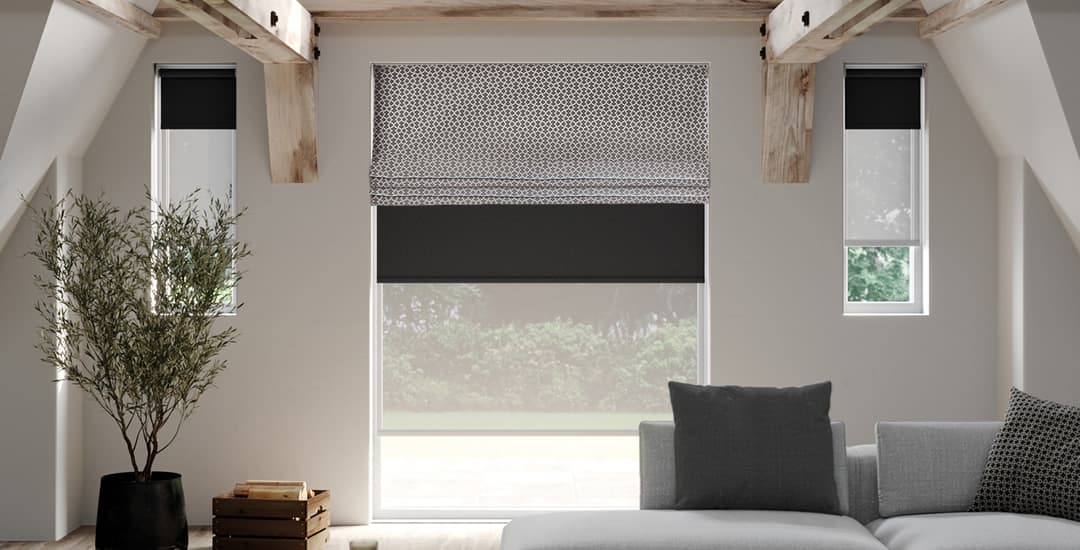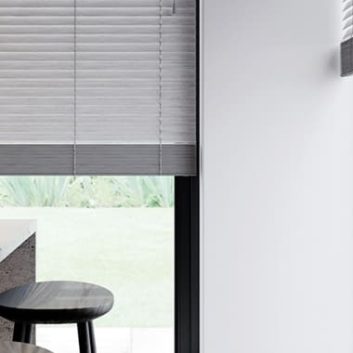
Can you put a Roman blind behind a roller blind, and why might you be considering doing this? Well first of all yes you can. While some people are a little taken aback at the idea of using two blinds on one window in the first instance, this is actually not at all unusual, and when you see the sort of appearance and finish this can achieve, most people immediately see that it’s a very viable design choice.
So, is putting a roller blind behind a Roman blind just an aesthetics thing, or does it serve a specific purpose? Generally both; using two blinds on a window when the inner-facing one is a Roman blind immediately ups your style game, but it can also ensure a 100% full blackout in rooms where this is important, and insulates the window in question to a superior degree too.
In this blog post I’ll firstly explain what I mean when I talk about putting a roller blind behind a Roman blind, and then provide a short roundup of the potential benefits or results of doing so.
Can you put a roller blind behind a Roman blind, and how does this work?
Yes, putting a roller blind behind a Roman blind is very much a thing; and this usually involves hanging the roller blind inside of the window recess with the Roman blind then hung over the window recess, making the Roman blind the only one you see when both blinds are fully closed.
You can adjust both blinds independently of each other too, so you may have the Roman blind open and the roller closed or partially closed at times, or any other variation of configurations you can think of.
Can you put a roller blind behind a Roman blind to ensure a full blackout?
Yes, and in fact using one blind inside of the window recess and another over it in this way is the only way to ensure that you will definitely achieve a 100% full blackout within the room in question when both blinds are fully closed, assuming that the blinds are made of the right materials.
It is not necessarily impossible to achieve a full blackout with just one blind, either hung inside of or outside of the recess; but this does tend to lead to a level of light leakage that cannot always be prevented, due to the gap between blind and window.
To ensure a full blackout using a roller blind behind a Roman blind, you don’t necessarily need to have both or even either blind made of blackout fabrics; but you would need to ensure they’re not overly fine or sheer either. Roman blinds tend to be made of thick and often, impermeable fabrics by design, even when not specifically made as blackout blinds, but the light-blocking effects of non-blackout roller blinds can be variable.
Fabric choice aside, when you’re hanging the Roman blind (the outer one, which will usually hang over the recess) ensure you have at least a 10cm border of coverage over the wall on all four sides of the window too, to ensure you achieve the blackout effect you’re after.
Can you put a roller blind behind a Roman blind to give you light filtering and dimming options?
Using a roller blind behind a Roman blind to give you a wider range of light-occluding options than you’d be able to achieve with one blind alone is a lesser-known but equally valid application of pairing up a roller with a Roman.
This relies on your choosing at least one or more commonly, both blinds in a non-blackout (dimout) fabric.
As an example, if you close both blinds you’ll maximise the darkness in the room, but separately closing each individual blind will result in a dimout effect; which might be notably different depending on which blind you close.
This gives you a wide range of potential options for light diffusion in the room; especially if you pick a thick Roman blind, and a sheer or lightweight Roman blind that permits a reasonable degree of light to pass through it even when closed.
Even if both the Roman blind and the roller blind are made of dimout rather than blackout fabrics, the effect of combining both layers when both blinds are closed will also often enable you to achieve a total or near-total blackout when you want to as well, as long as the fabrics of both blinds are reasonably opaque on their own.
In terms of light filtering rather than dimming/diffusing the light in a uniform fashion, this isn’t something that can really be achieved in the true sense of the word using a Roman or roller blind or both in combination; unlike some other types of blinds with tiltable slats or louvres, both Romans and rollers can only be opened or closed in one flat expanse of fabric.
Can you put a roller blind behind a Roman blind to insulate a window?
Yes, and this would in fact probably be the most effective approach to take to using blinds to insulate a window overall. Roman blind fabrics are thick and provide excellent insulation on their own; pair that with a roller blind with a special thermally insulating lining, and the two blinds will work together to help to maintain the temperature of the room.
Most obviously, this will allow you to keep more of your heating spend inside of the house and reduce drafts in winter, but it can also help to take the edge off rooms that get uncomfortably hot in summer if you keep both blinds closed during the day.
If you have single-glazed windows, very large windows, or your windows are otherwise a large source of heat loss in your room or the weak spot in your insulation, a roller blind/Roman blind combo might actually pay for itself within a couple of years in terms of the saving it could allow you to make on your energy bills.
Can you put a roller blind behind a Roman blind to create an opulent appearance in the room?
Yes, as well as the functional benefits or options that hanging a roller blind behind a Roman blind offers, it can also create a really show-stopping appearance and make a real feature of the window, even over and above that achieved by using a Roman blind on its own.
This can make a real impact, whether you want to restyle your bedroom into an opulent boudoir or take your lounge or living room to the next level; pairing a roller blind with a Roman blind definitely constitutes a real upgrade to the style of any room!
How do you fit a roller blind behind a Roman blind?
Most commonly, you’d fit the roller blind inside of the window recess and the Roman blind outside of the recess; and it is not possible to hang both blinds together outside of the recess.
However, you may in some cases be able to hang both blinds inside of the recess; albeit this might detract somewhat from the visual impact of the pairing.
If you do wish to go this latter route, there are a few things you need to take into account, and you should check them carefully as this might not be possible at all on some types of window recesses.
First up, measure the depth of your window recess, as you’ll need to ensure before you order that both blinds will physically fit within the space.
The depth of roller blinds and Roman blinds respectively can vary depending on where you buy them from; but for our blinds specifically, the depths you may be working with are:
- Face-fixed roller blinds: 70mm.
- Top-fixed roller blinds: 50mm.
- Roman blinds (both top-fixed and face-fixed): 50mm.
This means that you’d need at least a 100mm or 120mm deep window recess to be able to consider this option, factoring in also a small buffer and the potential challenges of being able to get into the recess to fit the second blind when the first one’s fittings are already in place, and how this may affect say, the angle you can get your drill or screwdriver in at.




